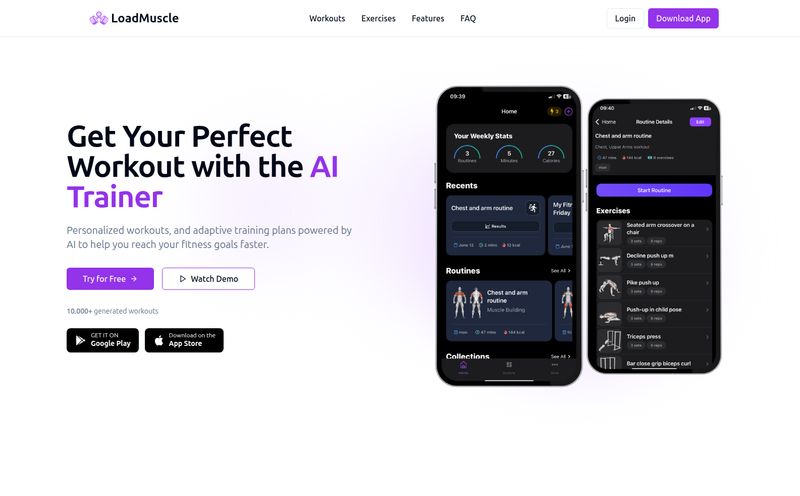You’ve been there. I’ve been there. We’ve all been there. You type a promising URL into your browser, maybe something you thought up in the shower that sounds like a million-dollar startup idea. You hit Enter, your mind racing with possibilities, and... you land on a page that looks suspiciously like a digital ghost town. A simple page, often with a few ads and a stark message: “This domain is for sale.”
It’s a bit of a letdown, isn’t it? The digital equivalent of finding a 'For Lease' sign on a storefront you were excited to check out. Recently, I stumbled upon autotextgenie.com, which presented exactly this scenario. A fantastic, brandable name, just sitting there. Parked.
But here’s a secret that separates the seasoned pros from the newcomers in the traffic and SEO game: these pages aren't dead ends. They're not 404s in disguise. They are often active pieces of digital real estate, part of a massive, often misunderstood, corner of the internet economy powered by services like Sedo Domain Parking. And honestly, there's a lot we can learn from them.
So, What Exactly is Domain Parking? (And Why Should You Care?)
Let's get this out of the way. Domain parking sounds... well, boring. But it’s one of the oldest hustles on the web. Think of it like this: you buy a plot of land in a promising location. You're not ready to build your dream house just yet, but you don't want to let it sit completely idle. So what do you do? You put up a billboard. You rent out the space for advertising, earning a little cash while you wait for the right time to build or for someone to come along and make you an offer you can’t refuse.
That's domain parking in a nutshell. A domain owner takes an unused domain name, points it to a parking service like Sedo, and the service automatically populates the page with pay-per-click (PPC) ads. The domain owner then earns a cut of the revenue generated when visitors click on those ads. It's a simple, hands-off way to either monetize a domain portfolio or to stick a giant, impossible-to-miss “For Sale” sign on your digital property.
For those of us in SEO and traffic generation, understanding this space is more than just trivia. It’s about spotting opportunities, understanding domain value, and knowing what’s happening on the other side of the “Buy this domain” button.
A Closer Look at the `autotextgenie.com` Page
The page for `autotextgenie.com` is a classic example of Sedo’s parking service in action. It’s clean, minimalist, and gets straight to the point. No fluff. Just the domain name and the call to action: “Buy this domain.”

Visit 美果123
This tells us two things. First, the owner is primarily interested in selling. They've opted for the direct sales approach over a page cluttered with ads. Second, they're using one of the biggest and most reputable platforms in the business to do it. Sedo (which stands for Search Engine for Domain Offers, a little fact I picked up years ago) is a behemoth in the domain aftermarket. They broker some of the biggest sales on record and manage a gigantic portfolio of parked domains.
And what a domain to be selling. In today's AI-obsessed world, a name like `autotextgenie.com` is gold. It’s memorable, brandable, and clearly communicates its purpose. Someone is sitting on a potentially very valuable asset, and they're using Sedo’s parking page as their 24/7 salesperson.
The Monetization Question: Can You Really Make Money Parking Domains?
Okay, let's talk brass tacks. Can you actually make decent money from the PPC ads on a parked domain? The honest answer is... maybe. But it's not a get-rich-quick scheme. Not by a long shot.
The revenue from a parked domain is almost entirely dependent on something called type-in traffic. This is when a user types the domain name directly into their browser bar, rather than finding it through a search engine. The domains that do best are often misspellings of popular websites, or generic, keyword-rich names that people might guess (like hotels.com back in the day). The CPC (cost-per-click) for these ads is typically quite low, so you need significant volume to see any real income.
“I experimented with parking a portfolio of about 50 domains a few years back. The revenue was enough to cover the registration fees and maybe buy me a few coffees each month. It’s a game of scale; a single domain, unless it’s an absolute traffic monster, won't pay your mortgage.”
So, while it's a feature, for most domainers—the folks who buy and sell domains for a living—the primary purpose of a parked page isn't the ad revenue. It's the visibility for a sale.
The Domain Flipper's Digital Showroom
This is where things get interesting for investors and entrepreneurs. A Sedo parking page is the most effective way to signal that a domain is available. Anyone who is interested in the name, like a startup that wants `autotextgenie.com` for their new AI writing tool, will land on that page and know instantly that it’s on the market.
What makes a parked domain valuable? It’s a bit of an art and a science, but I’ve always judged them on a few core factors:
- Brandability: Does it roll off the tongue? Is it catchy? `autotextgenie` is fantastic. `best-cpc-seo-services-tx.com`... not so much.
- Length: Shorter is almost always better. Easier to remember, easier to type.
- Keywords: Does it contain high-value keywords? “autotext” is a great one right now.
- TLD: The domain extension matters. A .com is still the king of the castle, commanding the highest value and trust.
- History: Has the domain been used before? A clean history is a must. A history of spammy activity is a major red flag.
I’ve spent countless hours scrolling through domain marketplaces looking for these digital nuggets of gold. It’s a modern-day treasure hunt, and parked pages are the maps telling you where X marks the spot.
What About SEO and Other Potential Problems?
A common question I get is, “Will buying a previously parked domain hurt my site's SEO?” It’s a valid concern. For years, Google has viewed parked pages as thin content or soft 404s—essentially, placeholders with no unique value.
However, in my experience, this isn't a permanent stain. Once you buy the domain and replace the parked page with a real, high-quality website, search engines are quick to re-evaluate. The old “parked” status gets wiped away as your new content is indexed. The key is to check the domain’s history before you buy. Use tools like the Wayback Machine and Ahrefs' backlink checker. Was it parked cleanly its whole life? Great. Was it a link farm for a shady online casino five years ago? Run away. Run far, far away.
Another thing to consider is the cost. Sedo doesn't publicly list a price for its parking service because it's generally free for the domain owner—Sedo takes a commission from any ad revenue or from the final sale price of the domain. This is pretty standard across the industry.
Is Sedo Your Only Option?
Of course not. The domain aftermarket is a bustling place. Platforms like Afternic, GoDaddy Auctions, and Dan.com all offer similar parking and brokerage services. Each has its own quirks and commission structures. I've always found Sedo's interface to be a bit... let's say, vintage. It's functional, but it hasn't changed much in a decade. However, their sheer volume of listings and global reach is hard to beat. They are a trusted third party that can handle escrow and transfers, which is crucial when thousands (or millions) of dollars are on the line.
Conclusion: More Than Just a Blank Page
So, the next time you land on a page like `autotextgenie.com`, don't just close the tab in disappointment. Take a second to appreciate what you're seeing. It’s a sign of a dynamic, liquid market for digital assets that’s humming along just beneath the surface of the web. It's an advertisement, a monetization tool, and a piece of digital real estate all rolled into one.
Whether you're looking to offload some of your own unused domains, hunting for the perfect name for your next project, or just curious about the internet's hidden economies, understanding domain parking is a valuable piece of the puzzle. It’s a reminder that even in the empty-looking corners of the internet, there's always business being done.
Frequently Asked Questions (FAQ)
- 1. What is domain parking in simple terms?
- Domain parking is the act of pointing an unused domain name to a service that displays advertisements. The domain owner earns a portion of the revenue generated when visitors click on these ads. It's also commonly used to clearly mark a domain as for sale.
- 2. How much does it cost to park a domain with a service like Sedo?
- Generally, parking a domain is free. The parking company, like Sedo, makes its money by taking a commission from the PPC ad revenue or a percentage of the final selling price if the domain is sold through their platform.
- 3. Can a previously parked domain hurt my website's future SEO?
- It's unlikely to cause long-term harm. As long as the domain has a clean history (no spam or shady activities), search engines will re-crawl and re-index the site once you launch your new content. The 'parked' status is temporary.
- 4. Is buying a parked domain a good investment?
- It can be, but it requires research. A good investment would be a short, brandable, keyword-rich .com domain with a clean history. Like any investment, it carries risks and requires you to do your due diligence.
- 5. How can I find out who owns a parked domain?
- You can start with a WHOIS lookup, but many owners use privacy services. The easiest way is often to follow the instructions on the parked page itself. Platforms like Sedo act as a broker, so you can submit an offer or inquiry directly through them.
- 6. What’s the difference between domain parking and just not using a domain?
- An unused domain that isn't parked will typically show a browser error page (DNS_PROBE_FINISHED_NXDOMAIN). A parked domain displays a live webpage with ads or a 'for sale' message, allowing it to potentially generate revenue or attract buyers.



